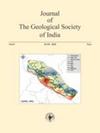拉克沙德韦普群岛一种现代珊瑚和一种化石珊瑚的高分辨率氧和碳同位素记录
IF 1.2
4区 地球科学
Q3 GEOSCIENCES, MULTIDISCIPLINARY
引用次数: 0
摘要
我们在此报告了拉克沙德韦普岛(Lakshadweep Island)的一个现代Porites珊瑚和一个化石Favia珊瑚的δ18O和δ13C记录,以解读海水特征的季节性变化。现代珊瑚是通过水下钻探卡瓦拉蒂岛的一个活体 Porites 群落获得的,而 Favia 珊瑚化石则是从同一岛屿的附近地点采集的。我们的解释主要基于对 378 个样本的高精度同位素测量。代表 25 年期间(公元 1984 年至 2008 年)的 Porites 珊瑚骨架 δ18O 值与 VPDB 值的比值介于-5.1‰和-4.37‰之间,而年龄大于 400 年的 Favia 珊瑚化石的 δ18O 值明显更高,与 VPDB 值的比值介于-4.75‰和-3.39‰之间。将现代 Porites 珊瑚的 δ18O 时间序列与研究区域现有的海表温度(SST)记录绘制成图,显示珊瑚 δ18O 与区域 SST 变化之间存在反比关系,表明温度是控制珊瑚季节带中 δ18O 的主要因素。两种硬骨鱼类珊瑚的 δ13C 值的季节性变化可能主要受溶解无机碳(DIC)δ13C 变化的影响。不过,碳同位素记录也显示了生物(代谢)过程对其 δ13C 的影响。Favia 珊瑚的 δ18O 和 δ13C 值比 Porites 珊瑚的 δ18O 和 δ13C 值的季节振幅更大,这意味着它们的新陈代谢过程存在明显差异。本文章由计算机程序翻译,如有差异,请以英文原文为准。
High-resolution Oxygen and Carbon Isotopic Records of a Modern and a Fossil Coral from the Lakshadweep Archipelago
We report here δ18O and δ13C records of a modern Porites and a fossil Favia coral from the Lakshadweep Island to decipher seasonal changes in seawater characteristics. The modern coral was obtained by underwater drilling of a live Porites colony of Kavaratti Island, whereas fossil Favia coral was collected from a nearby location of the same island. Our interpretation is mainly based on high-precision isotopic measurements of 378 samples. The skeleton δ18O values of Porites coral, representing a period of 25 years (between 1984 and 2008 AD), vary between – 5.1‰ and – 4.37‰ vs VPDB, whereas δ18O values of a >400 yrs old fossil Favia coral exhibit significantly greater δ18O values, ranging from – 4.75 to – 3.39‰ vs VPDB. A plot of δ18O time series of modern Porites coral with the available sea surface temperature (SST) record of the study area exhibits an inverse relationship between coral δ18O and regional SST changes, suggesting temperature as the dominant factor for controlling δ18O in seasonal bands of corals. Seasonal variations in δ13C values in both the scleractinian corals were probably influenced mainly by variations in δ13C of dissolved inorganic carbon (DIC). However, carbon isotopic records also indicate the effects of biological (metabolic) processes on their δ13C. The greater seasonal amplitude recorded in δ18O and δ13C values of Favia coral than in Porites coral implies a marked difference in their metabolic processes.
求助全文
通过发布文献求助,成功后即可免费获取论文全文。
去求助
来源期刊
CiteScore
2.20
自引率
7.70%
发文量
233
审稿时长
6 months
期刊介绍:
The Journal aims to promote the cause of advanced study and research in all branches of geology connected with India, and to disseminate the findings of geological research in India through the publication.

 求助内容:
求助内容: 应助结果提醒方式:
应助结果提醒方式:


